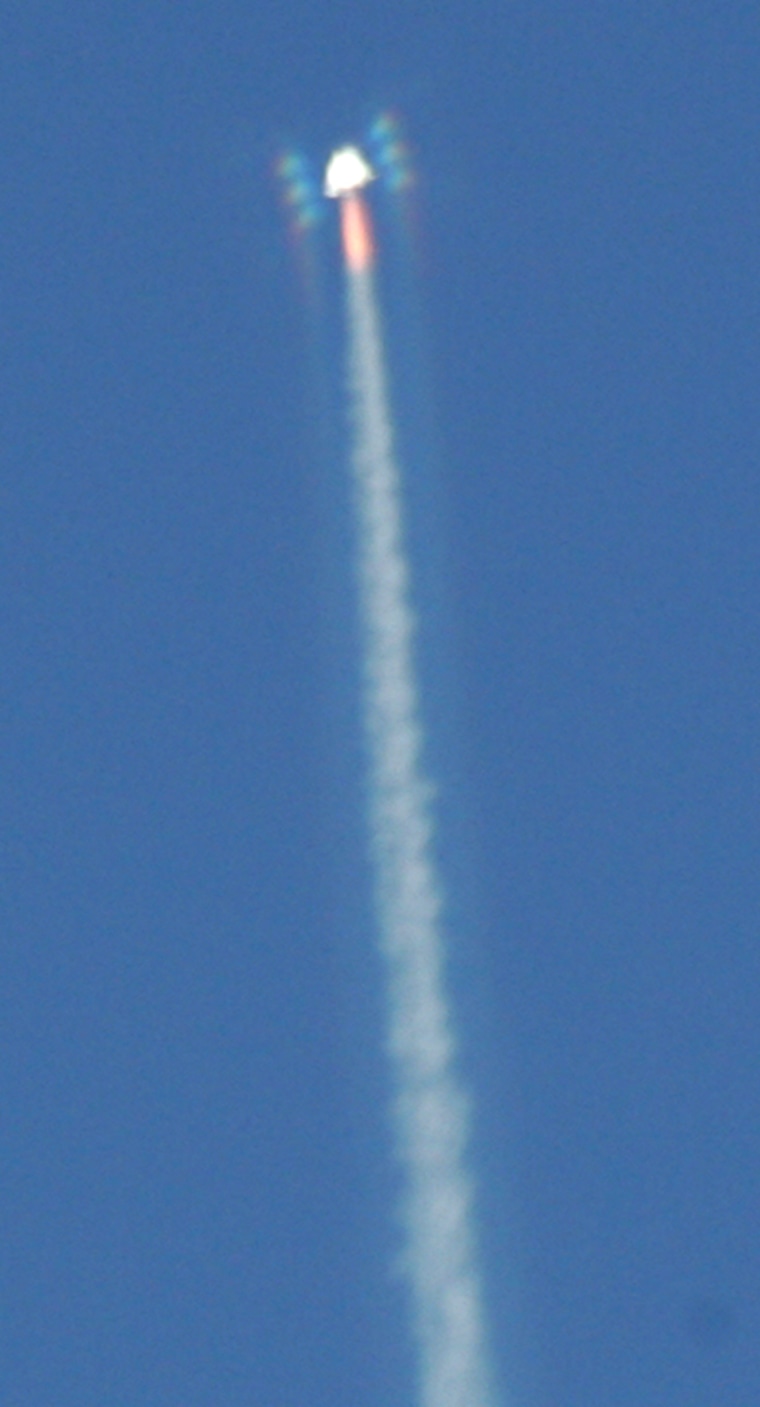The team behind the SpaceShipOne rocket plane says it plans to win the $10 million Ansari X Prize on Monday, after deciding that the unexpected aerial roll encountered during this week’s first X Prize flight was not serious enough to warrant further delay in the crucial second flight.
The St. Louis-based X Prize Foundation announced the timing of SpaceShipOne’s payoff space shot on Thursday, and also confirmed that Wednesday’s flight satisfied the requirements for winning the prize by rising above the 100-kilometer (62.5-mile) mark.
“It is a valid launch,” Peter Diamandis, the foundation’s president and founder, told MSNBC.com.
For now, the recorded altitude stands at 337,500 feet (63.9 miles or 102.9 kilometers). That figure could yet change, because X Prize officials “haven’t gotten the full data set” from trackers at Edwards Air Force Base, Diamandis said. But considering the margin of error, the prize judging committee decided to certify the flight Thursday, he said.
The X Prize, established eight years ago, offers $10 million to the first team to send a privately developed craft above 100 kilometers, the boundary of outer space, twice in a two-week timeframe. The spaceship must carry a pilot as well as extra cargo to represent the weight of two passengers, for a total of 594 pounds (270 kilograms).
Diamandis said the SpaceShipOne team told him that a Monday launch was “95 percent certain.” The 5 percent uncertainty was attributed to such factors as weather, he added.
The late-afternoon decision fulfills a pledge made by SpaceShipOne’s designer, Burt Rutan of Mojave-based Scaled Composites, that the launch date would be set by the end of Thursday’s business day. Scaled Composites had no further comment on the X Prize bid Thursday afternoon.
Monday could mark a red-letter day for space history, or at least a big payday for Rutan and the SpaceShipOne effort’s financial backer, software billionaire Paul Allen. Allen has invested more than $20 million in the venture and has said he is looking forward to recouping some of his expenses.
Two tough flights
SpaceShipOne first broke the outer-space barrier back in June. However, Wednesday’s flight was the first time the ship made it to space satisfying all the X Prize requirements, including the weight specifications.
Both of those spaceflights were flown from the Mojave Airport here by Mike Melvill, a veteran test pilot at Mojave-based Scaled Composites. And neither was easy.
In June, wind shear and a control-system glitch sent the spacecraft off course, and Melvill had to guide the ship back to its landing strip after weathering accelerations almost five times the force of Earth’s gravity. On Wednesday, SpaceShipOne unexpectedly went into a roll during its rocket engine burn, leading Melvill to shut off the engine early.
In both cases, Melvill successfully brought the craft under control, glided down to a perfect landing and made light of the experience afterward.
“At the top we got a little bit of a rolling motion, but I think it looks good for the crowd if you can roll at the top of the climb,” Melvill said at Wednesday’s postflight news conference, drawing a big laugh from reporters. “I think we did about 20 turns, and there were some pretty high rates there, but again, Burt’s designed a system that allowed me to stop the rates. I turned on the reaction jets, stopped the rates, I brought it to a complete standstill in space. ... This is not going to affect the second attempt at all.”
Potential causes
Melvill said “it’s possible that I stepped on a rudder when I shouldn’t have,” but Rutan said both spaceflights may have been made trickier by a long-acknowledged design deficiency in SpaceShipOne.
“Since its early testing, we’ve been living with a known deficiency in its flying qualities, in that it has too much dihedral effect,” Rutan said.
This effect relates to how an airplane’s wings respond to side winds or sudden gusts. On most planes, the wings are angled up slightly, so that the different airflows on each side would tend to stabilize the plane. On SpaceShipOne, that angled effect is too pronounced, resulting in a tendency for the craft to roll, Rutan said.
“It’s difficult to predict once you have an airplane flying,” he said. “It’s easy to fix on the second airplane, and we have very good fixes for excess dihedral effect for our next spaceship, and we’ve qualified that.”
That next spaceship could well be part of the development program for the Virgin Galactic suborbital fleet, announced on Monday by Rutan and Richard Branson, the chairman of Britain’s Virgin Group.
Some rocket enthusiasts speculated after the flight that asymmetric rocket thrust, perhaps due to changes in the nozzle shape during the engine burn, may have contributed to the roll. However, no problems with the engine or its nozzle were mentioned during Wednesday’s news conference. In fact, Rutan told reporters that the motor was “in beautiful shape.”
Robust design
Rutan said Melvill’s wild ride and smooth landing showed that SpaceShipOne’s design was robust enough to handle problems that might have doomed other spacecraft.
“When you end up with a high roll rate, and you didn’t plan to do it, in a manned spacecraft, that’s normally a very, very big deal,” he said. “That would be an accident if it happened on the space shuttle or the X-15, and we would be looking for small pieces now. ... Any system that will ever go out there and fly space tourists needs to be 100 times or more safer than any manned spacecraft that has ever flown.”
He said that tests involving SpaceShipOne and its successors would result in spaceships that would meet that standard.
“We are extremely confident that we are going to be able to produce the first space tourism commercial spaceliner that will start out service with reliability, I believe, significantly better than the first airlines had when they started doing service decades ago.”
